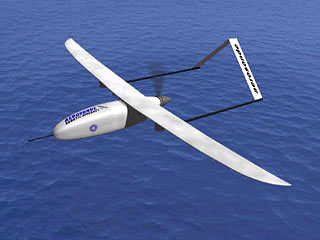
|
 Unmanned Atlantic Crossing
Unmanned Atlantic Crossing
by Iain Maciver, Stornoway THE first-ever unmanned aircraft to cross the Atlantic has today landed in the Western Isles of Scotland.
It was about 26 hours before that the 10ft-wingspan one-cylinder Aerosonde, nicknamed Laima, set off from Bell Island airstrip in St Johns, Newfoundland. Incredibly, its tiny one-cylinder engine needed less than two gallons of aviation fuel to zoom across the Atlantic and land at 13:48 UK time. It was a triumphant end to a frustrating week for the team of record-breaking engineers and scientists. One of their craft crashed on take-off on Monday and another was lost in the ocean. Bill Vaglienti, the aeronautical engineer from project operator Insitu, a small-scale Washington aerospace reasearch company, said: "I am very tired and very excited...This has been a great day....We had been feeling very low until now but now we have the world record. "It was a great, quick landing with no damage at all." As well as snatching the world record, the aircraft was packed with tiny computerised weather recording equipment. Laima now goes into the history books as the successive record-breaker to Charles Lindbergh's first solo transatlantic flight from New York to Paris in 1927 and, before that, Alcock and Brown's crash-landing in Ireland in 1919. Insitu has stolen the thunder of another large company, Teledyne Ryan Aeronautical of San Diego, the company that built the Spirit of St Louis for Lindbergh, which planned to grab the record next year. Vaglienti, from Seattle, said proudly: "Whenever Teledyne Ryan get round to trying the unmanned crossing they will know that we did it first." He paid tribute to the Defence Evaluation Research Agency (DERA), the military department that run the South Uist range, and to Ian Davies, the director of UK aerospace policy, who was on Uist this week to help with the project. Yet another unmanned aircraft, named Millionaire, was also launched by Insitu two hours after Laima and was also due to arrive on South Uist in the late afternoon. The robot planes travelling at 40 knots, had an autopilot system set aiming for a point in the sea off the Military Range on South Uist. The aproach and landing at the South Uist range was handled, just like any radio-controlled model plane, by Bill Vaglienti. He used a typical, if slightly modified, radio modellers' handset. The Aerosondes' planned record-breaking crossing over nearly 2,000 miles took just over 24 hours. They flew at 6,000 feet, to prevent icing and other aircraft, until they reached UK airspace, at 10 degrees west, when strict British flying regulations meant they had to fly in at just 400 ft. Insitu says the transatlantic demonstration is not just to get in the record books but to improve short-term and long-term weather forecasts for the western seaboard and longer-term forecasts for the eastern seaboard of the US. Its rival, Teledyne Ryan Aeronautical of San Diego, is an aerospace giant with longtime roots in Atlantic crossings and had planned its sophisticated Global Hawk unmanned airplane from California to France for the Paris Air Show in June next year. It has become a David and Goliath tussle with Insitu now taking the glory from a well-heeled giant that is the world leader in pilotless aircraft. Ryan's Global Hawk is being developed for the Defense Department at a cost of $200 million, including the first six aircraft. Production models are expected to cost $7 million each. The Aerosonde rolled off the assembly line at just $15,000 each. The only thing they have in common is that neither has a pilot aboard. Despite the light-hearted rivalry, the stakes are high. The international aerospace industry wants greater acceptance of pilotless aircraft. Today's successful flight across the Atlantic will help boost public confidence in the reliability and safety of unmanned aircraft. The US Department of Defense has been the prime driver behind the development of unmanned air vehicles, or UAVs as they are called, because of the obvious advantage of taking the pilot out of dangerous situations, such as towing aerial targets. There is a growing interest by the civilian sector as cheap pilotless craft could be used for everything from monitoring crops, pipelines or aqueducts, to damage assessment following a natural disaster, such as a flood or an earthquake. The historic landing in Scotland was being monitored around the world and in Melbourne, Australia, project partners Environmental Systems and Services' Jon Becker sent an immediate message to South Uist saying: "Congratulations are in order. We'll open the Domaine Chandon now." ENDS
Iain X. Maciver, Scottish News Reporter
|
Return to Aerobotics Home
© Copyright 1999 CTIE - All Rights Reserved - Caution |